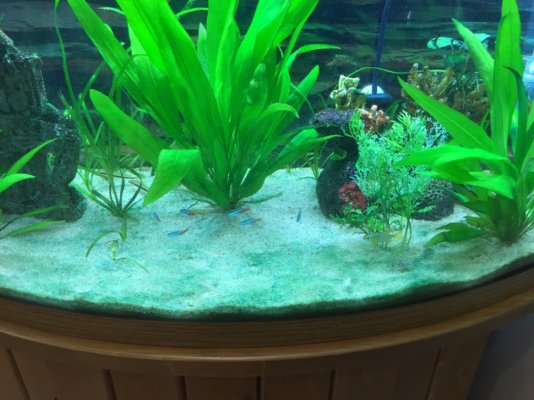Just curious for future reference. Does dosing EM affect the bio filter?
Sent from my iPhone using Aquarium Advice
I've wondered that myself. IME and observations on this forum, it appears okay for use with the BB. Meaning, I did not detect a mini-cycle through testing. Then again, I keep a low fish bioload with lots of plants so whose to say that the plants do not pickup the slack with the ammonia and nitrite. I think the key is "used as directed" with medications.
Here is an interesting discussion on the topic,
http://www.cichlid-forum.com/phpBB/viewtopic.php?t=238445 particularly this excerpt quoted below. The answer according to this post appears to be "Yes" although there are other factors that come into play.
"Gram-negative bacteria are pathogenic in nature, since they can cause disease in a host organism and have a thin cell wall. Gram negative bacterial infections are much more common in fish, especially marine.
Some Gram Negative Bacteria:
- Aeromonas (anaerobic)
- Furunculosis; Aeromonas-salmonicida (anaerobic)
- Vibrio (anaerobic)
- Flavobacterium (Columnaris) (aerobic)
- Pseudomonas (aerobic)
- Streptobacillus (anaerobic)
- Salmonella (anaerobic)
Gram-positive bacteria do not always cause a disease in the host organism and have a very thick cell wall. Gram positive infections are less common in fish (or aquaria in general).
Some Gram Positive Bacteria:
- Mycobacterium (aquatic tuberculosis)
- Streptococcus (aerobic)
- Pseudonocardia (anaerobic)
-Staphylococcus (aerobic)
- Cyanobacteria (Oxygenic Phototrophic)
Coming to the issue of Nitrifying bacteria which are Aerobic Chemolithotrophic Bacteria :
- Nitrobacteraceae (aerobic)
- Nitrobacter (aerobic)
- Nitrococcus (aerobic)
- Nitrospina (aerobic)
- Nitrospira (aerobic)
- Nitrosococcus (aerobic)
- Nitrosolobus (aerobic)
- Nitrosomonas (aerobic)
Anaerobic Chemotrophic Bacteria
- Erythrobacter (anaerobic)
Another issue of importance is whether the antibiotic mediaction will kill the Nitrifying Bacteria inside the tank. So how do medications affect the beneficial bacteria ?
Antibiotics killing the nitrifying bacteria is ONLY true for gram positive antibiotics or overuse of others. Most true nitrifying bacteria (Autotrophic bacteria) are gram positive whilst the majority of aquarium infections are gram negative. So use of gram positive antibiotics such as Erythromycin has a greater risk of a nitrifying bacteria die-off than Kanamycin (which is both gram negative and gram positive, however it is more effective against gram negative bacteria). Some antibiotics are mixed. Ex. Tetracycline families, which are often equally divided such as Minocycline; however Tetracycline Hydrochloride is primarily a gram positive.
Erythromycin and Ampicillin are gram positive bacteria and can be harmful to beneficial bacteria. Erythromycin is also effective for Cyanobacteria.
Diseases in the aquarium can be of 3 types - Parasitic, Bacterial & Viral. Parasitical infection in most cases may be treated with Bath treatment. For Bacterial infection, antibiotics or a combination may work. However, for Viral infection, personally, I am very doubtful of the effectiveness of Antibiotics. Like in the case of humans, the antibodies within our body fight against these viruses. This disease last for 4-5 days and subsides on its own. Antibiotics have no effect on its treatment. Antibiotics are given during Viral infection not to treat it, but to prevent any other secondary infection which may arise during the course of treatment.
Some precautions to be taken during medication -
1) Remove Carbon (& some other chemical filter media)
2) Water Changing :
Changing water immediately prior to each treatment can improve the effectiveness and lower the possible toxicity of treatment. Organics present in the tank water can absorb the medication and thus reduce the effectiness of the medications. A 20% or larger, water change is recommended before medication. Some medications break down after 24-48 hours and can leave mildly to moderately toxic chemicals behind which a water change (or even running carbon in a filter for an hour or two) prior to the next treatment can help lower/remove."
Sent from my iPhone using Aquarium Advice

